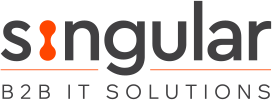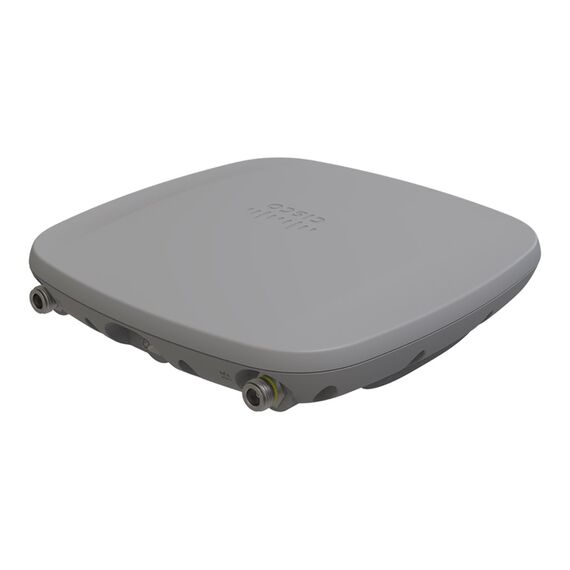Cisco Catalyst 9163E - Radio access point - 1GbE, 2.5GbE - Bluetooth, Wi-Fi 6E - 2.4 GHz, 5 GHz, 6 GHz | CW9163E-E
Product Features
- Wi-Fi 6 and Wi-Fi 6E (802.11ax)
The IEEE 802.11ax standard, also known as High-Efficiency Wireless (HEW) or Wi-Fi 6, builds on 802.11ac. It delivers a better experience in typical environments with more predictable performance for advanced applications such as 4K or 8K video; high-density, high-definition collaboration apps; all-wireless offices; and the Internet of Things (IoT). Wi-Fi 6E is Wi-Fi 6 "extended" into the 6-GHz frequency band. - AP power optimizations (AP Power Save mode)
AP Power Save mode allows the access point to reduce its power consumption by shutting off radios during off-hours and weekends - while still being smart enough to reengage all features should they be needed. This both saves power and reduces the carbon footprint of running a wireless network. - CleanAir Pro
Cisco CleanAir Pro applies Cisco's industry-leading RF interference detection and classification to the 2.4-GHz, 5-GHz, and 6-GHz bands. - Client steering
Client steering helps clients that are 6-GHz capable leave the 5-GHz radio and connect to the 6-GHz radio. Wi-Fi 6E clients are automatically directed to connect to the 6-GHz radio to take advantage of the benefits it offers and free up the 2.4-GHz and 5-GHz radios for legacy clients. - Uplink/downlink OFDMA
Orthogonal frequency-division multiple access (OFDMA)-based scheduling splits the bandwidth into smaller frequency allocations called resource units (RUs), which can be assigned to individual clients in both the downlink and uplink directions to reduce overhead and latency. - Uplink/downlink MU-MIMO technology
Supporting the highest number with 6 spatial streams, multiuser multiple input, multiple output (MU-MIMO) enables the access points to split spatial streams between client devices to maximize throughput. - BSS coloring
Spatial reuse (also known as Basic Service Set [BSS] coloring) allows the access points and their clients to differentiate between BSSs, thus permitting more simultaneous transmissions. - Target Wake Time (TWT)
TWT allows the client to stay asleep and to wake up only at prescheduled (target) times to exchange data with the access point. This offers significant energy savings for battery-operated devices, up to three to four times the savings achieved by 802.11n and 802.11ac. - Intelligent Capture
Intelligent Capture probes the network and provides Cisco Catalyst Center with deep analysis. The software can track more than 240 anomalies and instantaneously review all packets on demand, emulating the onsite network administrator. - Application hosting
Application hosting helps simplify IoT deployments and ready them for the future by eliminating the need to install and manage overlay networks. Using the USB interface, containerized applications and hardware modules can be deployed to reduce cost and complexity. Adding Cisco Catalyst Center provides workflows and deployment-wide application lifecycle management. - Bluetooth 5.1
The integrated Bluetooth Low Energy (BLE) 5.1 radio enables location-based use cases such as asset tracking, wayfinding, and analytics. - Self-identifying antenna
The access point is able to read information from antennas that support the Self-Identifying Antenna (SIA) feature and automatically populates antenna gain for plug-and-play antenna configuration. - Container support for applications
Container support enables edge computing capabilities for IoT applications on the host access point.
Special Fetures
- Wi-Fi 6 and Wi-Fi 6E (802.11ax)
- AP power optimizations (AP Power Save mode)
- CleanAir Pro
- Client steering
- Uplink/downlink OFDMA
- Uplink/downlink MU-MIMO technology
- BSS coloring
- Target Wake Time (TWT)
- Intelligent Capture
- Application hosting
- Bluetooth 5.1
- Self-identifying antenna
- Container support for applications
Product Specification
| Device Type | Radio access point |
| Ruggedized Design | Outdoor |
| Built-in Devices | GPS |
| Width | 24.5 cm |
| Depth | 24.5 cm |
| Height | 6.35 cm |
| Weight | 1.5 kg |
| Processor / Memory / Storage | |
| RAM | 2 GB |
| Flash Memory | 1 GB |
| Networking | |
| Form Factor | External |
| Connectivity Technology | Wireless |
| Line Coding Format | 1024 QAM, OFDMA |
| Data Link Protocol | Fast Ethernet, Gigabit Ethernet, IEEE 802.11b, IEEE 802.11a, IEEE 802.11g, IEEE 802.11n, IEEE 802.11ac, 2.5 Gigabit Ethernet, Bluetooth 5.1 LE, IEEE 802.11ax (Wi-Fi 6E) |
| Spread Spectrum Method | OFDMA |
| Remote Management Protocol | HTTP |
| Frequency Band | 2.4 GHz, 5 GHz, 6 GHz |
| Capacity | Spatial streams: 12 |
| Status Indicators | Status |
| Features | Maximum Ratio Combining (MRC), cyclic shift diversity (CSD), Client Steering, beamforming technology, packet aggregation A-MPDU, packet aggregation A-MSDU, Tri-Band, Dynamic Frequency Selection (DFS), secure boot, 2x2:2 MU-MIMO technology, PowerSave, image signing, Cisco Trust Anchor module, BSS Coloring, Target Wake Time (TWT), CleanAir Pro technology, self-identifiable aerials (SIA) support |
| Encryption Algorithm | AES, PEAP, WPA2-Enterprise, EAP-SIM, WPA3, WPA3-Personal, EAP-FAST, WPA3-Enhanced Open, WPA2-Personal, EAP-TLS, EAP-TTLS, MSCHAPv2, EAP-GTC, PEAPv1 |
| Authentication Method | MS-CHAP, MS-CHAP v.2, Extensible Authentication Protocol (EAP), EAP-FAST, EAP-SIM |
| Compliant Standards | IEEE 802.3, IEEE 802.3ab, IEEE 802.11b, IEEE 802.11a, IEEE 802.3af, IEEE 802.11d, IEEE 802.11g, IEEE 802.11h, IEEE 802.11n, IEEE 802.3at, IEEE 802.15.4, IEEE 802.11ac, IEEE 802.11ax, IEEE 802.15.1 |
| Internet of Things (IoT) | |
| Internet of Things (IoT) Compatible | Yes |
| Communications Technology | Bluetooth Low Energy (LE), Thread, Zigbee |
| Expansion / Connectivity | |
| Interfaces | 1 x 100M/1G/2.5/5 Gigabit Ethernet (PoE+) - RJ-45 ¦ 1 x management - RJ-45 ¦ 1 x USB ¦ 4 x aerial - N connector |
| Miscellaneous | |
| Compliant Standards | IEC 60950-1, EN 60950-1, WEEE, CNS 13438, IEC 60950-22, EN 60950-22, CISPR 24:2010, RSS-247, EN 62368-1, IEC 62368-1, AS/NZS 2772.2, CAN/CSA-C22.2 No. 62368-1, CAN/CSA-C22.2 No. 60950-1, AS/NZS CISPR32:2015 Class B, VCCI-CISPR 32:2016, CISPR 32:2015, ARPANSA, EN 55035:2017, QCVN, RSP-100, RSS-GEN, AN/NZS 60950.1, EN 301 893 V2.1.1, AS/NZS 4268:2017, ETSI EN 300 328 V2.2.2 (2019-07), FCC CFR47 Part 1 1.1310, EN 50385:2017, AS/NZS 62368.1, EN 61000-3-2:2019, 47 CFR Part 2.1091, QCVN 112:2017, QCVN 18:2014, EN 55032:2015/A11:2020, EN 61000-3-3:2013+A1:2019, EN 301 489-17 V3.2.4 (2020-09), EN 301 489-1 V2.2.3 (2019-11), KS X 3124:2020, KS X 3126:2020, ICES-003 issue 7 Class B, KS C 9835:2019, CAN/CSA-C22.2 No. 60950-22, KS C 9610-3-3:2020, KS C 9610-3-2:2020, FCC CFR 47 Part 15 Class B, FCC CFR 47 Part 15C, KS C 9832:2019, FCC CFR Part 15.247, FCC CFR Part 15.407, EN 55024:2010 + AMD 1, LP0002:2020, QCVN 54:2020, QCVN 65:2013, RSS-102:2015, QCVN 118:2019 |
| Power | |
| Power Over Ethernet (PoE) Supported | PoE+ |
| Software / System Requirements | |
| OS Required | Cisco IOS XE 17.13.1 or later |
| Manufacturer Warranty | |
| Service & Support | Limited warranty - advance hardware replacement - 1 year - response time: 10 days |
| Environmental Parameters | |
| Min Operating Temperature | -40 °C |
| Max Operating Temperature | 65 °C |
| Humidity Range Operating | 5 - 95% (non-condensing) |
Features - Cisco - CW9163E-E
No posts found











